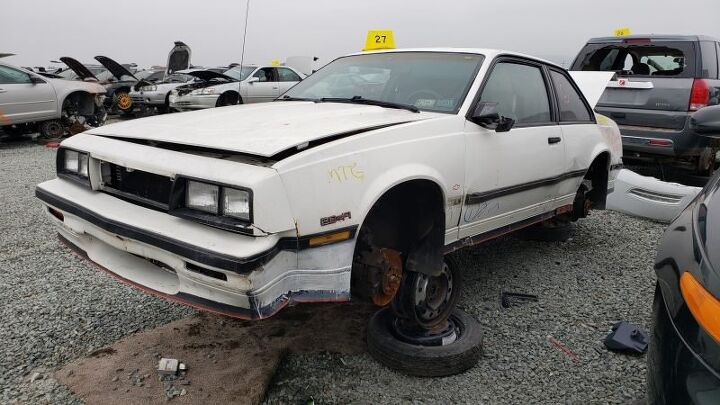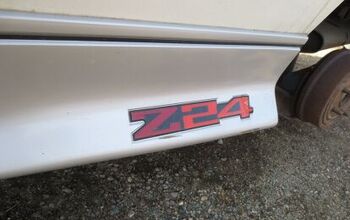4.1K Views
Junkyard Find: 1987 Chevrolet Cavalier Z24 Sport Coupe

by
Murilee Martin
(IC: employee)
Published: February 28th, 2022
Share
Since I’ve noticed in recent years that first-generation Chevy Cavaliers have all but disappeared from both street and junkyard on our continent, despite the millions sold here, I’ve made it my mission to document examples of the now-rare 1982-1987 Cavalier when I see them during my wrecking-yard travels. We admired a Yooper-owned ’85 Cavalier wagon in a Colorado yard in November, and I found today’s factory-hot-rod ’87 Cavalier Z24 in a Northern California yard in December.
In fact, this car was parked just a couple of rows away from another 2.8-engined GM sporty machine of the middle 1980s: The ’84 Pontiac 6000 STE that we saw last week. If you want to find unrusted Detroit machinery from 35 years ago, head west!
Now, that 6000 STE was built on the midsize A Platform and the Cavalier lived on the compact J Platform, plus the 6000 STE was the most expensive car offered by Pontiac at the time, so we shouldn’t look for too many parallels with the much cheaper Cavalier Z24 (in 1987, the 6000 STE started at $18,099 while the Z24 Sport Coupe listed at $9,913— about $45,760 and $25,065 in 2022 dollars, respectively).
The Chevrolet Division had been selling Z28 Camaros for nearly a decade when the first Z24 Cavaliers hit the showrooms for the 1986 model year; eventually, we would see Z26 Berettas and Z34 Luminas (it is my dream to convince a 24 Hours of Lemons team to run a four-car effort with one apiece Z24, Z26, Z28, and Z34). In 1987 the owner of a new Z24 got this 2.8-liter pushrod V6, rated at 160 horsepower. That was good power for a car of its era that scaled in at just over 2,500 pounds.
Better still, the Z24 came standard with a five-on-the-floor manual transmission (a three-speed automatic cost $415 extra, about $1,050 in 2022 frogskins), and the original purchaser of this car bucked prevailing transmission trends and chose the three-pedal setup.
The five-speed manual had become fairly mainstream by the middle 1980s but still seemed racy enough; today, Americans can still buy four new 2022 models with five-speed manuals.
The Cavalier Sport Coupe came standard with this futuristic digital dash (which looked a bit stodgy next to the offerings from Mitsubishi and Subaru); other Cavalier shoppers could get this dash for a mere $295 extra (about $745 now).
I’m not sure if the trip computer came along with the digital instrument cluster, but all 1987 Z24 buyers got an AM radio as base equipment; if you wanted to upgrade to AM/FM/cassette with equalizer— a necessity for listening to the most famous song of 1987 in all its glory— the price tag was a brutal $479 ($1,210 now).
The 1987 Z24 could be purchased as a sport coupe with a proper trunk, and that’s what 42,890 Chevy shoppers did. Four thousand and five-hundred seventeen Cavalier Z24 buyers decided to hop onto the hot hatch bandwagon, however, and drove home in new hatchbacks (I’ve managed to find just one Z24 hatch in all of my junkyard explorations).
Since this car has a full complement of Z24 hardware elsewhere, I’m going to assume that the decklid from a lowly CL got swapped on long after it rolled off the line at Lordstown and that we’re not looking at a Z24-ized Cavalier CL coupe.
The inspection stickers show that this car was in North Carolina in 1991 (where it was approved for daylight use only, and I’d like to know more about that restriction), then in Connecticut in 1996.
Definitely the most interesting Cavalier of its time, and soon it shall face the cold steel jaws of The Crusher.
{
"id": "9151118",
"alt": "YouTube video player",
"title": "YouTube video player",
"video_link": "https://www.youtube.com/embed/JfLpJ1srsg0",
"youtube_video_id": "JfLpJ1srsg0"
}
{
"width": 634,
"height": 357,
"showRelated": true
}
A new Cavalier with the bloodline of Corvette and Camaro. A quick little fox… raised by wolves.
{
"id": "9151136",
"alt": "YouTube video player",
"title": "YouTube video player",
"video_link": "https://www.youtube.com/embed/uOJIEIx9K_s",
"youtube_video_id": "uOJIEIx9K_s"
}
{
"width": 634,
"height": 357,
"showRelated": true
}
Cavaliers were everywhere by 1987.
{
"id": "9151139",
"alt": "YouTube video player",
"title": "YouTube video player",
"video_link": "https://www.youtube.com/embed/C6RNlHEObD4",
"youtube_video_id": "C6RNlHEObD4"
}
{
"width": 634,
"height": 357,
"showRelated": true
}
This commercial is for the second-generation ’88 Cavalier Z24, but it does such a perfect job of showing us who The General’s marketers saw as the Z24’s target market that I must include it here. I’m sure glad the bandanna-around-the-wrist fashion never caught on because the 1980s were already sufficiently embarrassing for those of us who were there at the time.For links to more than 2,300 additional Junkyard Finds, please visit the Junkyard Home of the Murilee Martin Lifestyle Brand™.
#1980s
#1987
#1987ChevroletCavalier
#California
#Cavalier
#Chevrolet
#ChevroletCavalier
#ChevroletCavalierZ24
#Chevy
#DownOnTheJunkyard
#GM
#GeneralMotors
#Junkyard
#JunkyardFind
#GMJBody
#GMJPlatform
#Z24
#SportCoupe
#SportCoupes
#Radwood

Murilee Martin
Murilee Martin is the pen name of Phil Greden, a writer who has lived in Minnesota, California, Georgia and (now) Colorado. He has toiled at copywriting, technical writing, junkmail writing, fiction writing and now automotive writing. He has owned many terrible vehicles and some good ones. He spends a great deal of time in self-service junkyards. These days, he writes for publications including Autoweek, Autoblog, Hagerty, The Truth About Cars and Capital One.
More by Murilee Martin
Published February 28th, 2022 9:00 AM
Latest Car Reviews
Read moreLatest Product Reviews
Read moreRecent Comments
- Honda1 Unions were needed back in the early days, not needed know. There are plenty of rules and regulations and government agencies that keep companies in line. It's just a money grad and nothing more. Fain is a punk!
- 1995 SC If the necessary number of employees vote to unionize then yes, they should be unionized. That's how it works.
- Sobhuza Trooper That Dave Thomas fella sounds like the kind of twit who is oh-so-quick to tell us how easy and fun the bus is for any and all of your personal transportation needs. The time to get to and from the bus stop is never a concern. The time waiting for the bus is never a concern. The time waiting for a connection (if there is one) is never a concern. The weather is never a concern. Whatever you might be carrying or intend to purchase is never a concern. Nope, Boo Cars! Yeah Buses! Buses rule!Needless to say, these twits don't actual take the damn bus.
- MaintenanceCosts Nobody here seems to acknowledge that there are multiple use cases for cars.Some people spend all their time driving all over the country and need every mile and minute of time savings. ICE cars are better for them right now.Some people only drive locally and fly when they travel. For them, there's probably a range number that works, and they don't really need more. For the uses for which we use our EV, that would be around 150 miles. The other thing about a low range requirement is it can make 120V charging viable. If you don't drive more than an average of about 40 miles/day, you can probably get enough electrons through a wall outlet. We spent over two years charging our Bolt only through 120V, while our house was getting rebuilt, and never had an issue.Those are extremes. There are all sorts of use cases in between, which probably represent the majority of drivers. For some users, what's needed is more range. But I think for most users, what's needed is better charging. Retrofit apartment garages like Tim's with 240V outlets at every spot. Install more L3 chargers in supermarket parking lots and alongside gas stations. Make chargers that work like Tesla Superchargers as ubiquitous as gas stations, and EV charging will not be an issue for most users.
- MaintenanceCosts I don't have an opinion on whether any one plant unionizing is the right answer, but the employees sure need to have the right to organize. Unions or the credible threat of unionization are the only thing, history has proven, that can keep employers honest. Without it, we've seen over and over, the employers have complete power over the workers and feel free to exploit the workers however they see fit. (And don't tell me "oh, the workers can just leave" - in an oligopolistic industry, working conditions quickly converge, and there's not another employer right around the corner.)









































Comments
Join the conversation
Murilee, did you notice that second video takes place in 1980s Denver? The beginning is a bunch of nondescript neighborhoods, but the Rocky Mountains are recognizable, and at the end, downtown Denver and Union Station are featured, including the now-defunct 16th Street viaduct. So cool!
As a poor college student, I had the polar opposite 87’ caviler to this. It was an absolute stripper the likes of which you cannot buy in any model or brand today. It had an incredibly monochrome color scheme of gray exterior with gray vinyl interior, 4sp stick, crank windows, mechanical locks, no A/C, no power steering and no . . . passenger side mirror. I don’t think a single options box, was checked unless it was a delete option by the original purchaser. It was pretty reliable considering the intentional and unintentional abuse it was saddled with, which included being driven for a few miles on the freeway with no oil after the oil pressure sending unit for the low oil pressure dummy light broke which itself created the pathway for the oil to be pumped out. Replaced sender (a whole another crazy story around that process) added oil, started up and didn’t seem to suffer any lasting ill effects. Murilee, maybe you can add a few more stripper cars like to that to your junk yard finds, cars that show what real entry level transportation used to look like?